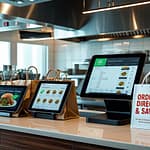Key Takeaways:
- Implement automation in kitchen operations to reduce manual tasks and increase efficiency.
- Explore smart tools such as automated ovens and AI-enabled dishwashers for cost and time savings.
- Use automation to streamline inventory management and reduce waste.
- Consider automated ordering systems to improve customer experience and order accuracy.
- Regularly analyze automation tool performance to ensure cost-effectiveness and ROI.
Can Automation Save Your Restaurant?
Automation tools that boost efficiency and cut cost
In today’s challenging restaurant landscape, rising labor costs, tight profit margins, and increasing customer expectations make it critical for restaurant operators to explore innovative solutions. Automation in restaurant operations has emerged as a powerful way to streamline tasks, enhance efficiencies, and significantly reduce expenses. But can smart tools and automation truly transform your restaurant business?
This article explores the practical benefits of automation, the most effective smart tools to adopt, and real-world examples of restaurants successfully leveraging automation to save costs and boost their bottom line.
Why Automation is a Game-Changer for Restaurants
Restaurants face continuous pressure to deliver high-quality food and exceptional service while managing operational overhead. Labor-intensive tasks, repetitive processes, and human error can drain resources and productivity. Automation provides a solution by:
- Reducing labor costs through efficient task handling
- Improving accuracy and consistency in food preparation and ordering
- Enhancing customer satisfaction through faster service
- Minimizing food waste and inventory losses
By adopting smart tools, restaurants can streamline kitchen operations and front-of-house processes, saving both time and money.
Smart Tools Driving Restaurant Automation
Automation in restaurant operations includes a variety of smart tools designed specifically to improve efficiency, accuracy, and profitability. Here are key categories of restaurant automation tools worth considering:
1. Automated Ordering Systems and Self-Service Kiosks
Automated ordering systems and self-service kiosks reduce wait times, minimize order errors, and free up staff to focus on customer service. Customers appreciate the convenience of quick, accurate ordering through digital interfaces.
- Self-order kiosks streamline customer ordering, reducing queues and speeding up service times.
- Online ordering platforms integrate with POS systems, ensuring orders move seamlessly from customer to kitchen.
- Mobile apps allow customers to order ahead, pick up quickly, and reduce crowding at peak times.
2. Kitchen Display Systems (KDS)
Kitchen Display Systems transform restaurant kitchens by digitizing order management, eliminating paper tickets, and improving communication between front and back-of-house teams.
- Digital screens clearly show orders in real-time, reducing confusion and increasing kitchen efficiency.
- KDS integrates with POS systems for seamless communication from customer order to kitchen preparation.
- Analytics features provide insights into kitchen performance, allowing managers to optimize processes and reduce delays.
3. Inventory Management Software
Inventory management software automates tracking and control of ingredients, supplies, and food waste. This reduces overhead costs by eliminating manual counting, minimizing waste, and preventing over-ordering.
- Automated inventory tracking ensures accurate stock levels, preventing ingredient shortages or spoilage.
- Real-time alerts notify managers about low-stock items, facilitating timely ordering decisions.
- Data-driven insights help restaurants forecast demand and optimize inventory purchasing.
4. Robotic and Automated Kitchen Equipment
Robotic and automated kitchen equipment takes automation further by replacing repetitive, labor-intensive tasks typically performed by kitchen staff. Examples include robotic fryers, automated grills, and smart cooking appliances.
- Robotic fryers maintain consistent cooking quality and reduce labor costs by automating frying processes.
- Automated grills and ovens ensure precise cooking temperatures and reduce human error.
- Smart appliances streamline kitchen operations, freeing staff to handle more creative or complex culinary tasks.
Real-Life Examples of Restaurants Embracing Automation
Restaurants worldwide are successfully implementing automation tools to drive efficiency, save costs, and improve customer satisfaction. Here are notable industry examples:
Case Study: McDonald’s and Self-Service Kiosks
McDonald’s has widely implemented self-service kiosks across thousands of locations globally. These kiosks have helped the fast-food giant significantly cut down on staffing costs, enhance order accuracy, and speed up service times. Customers report greater satisfaction due to shorter waiting times and a more personalized ordering experience.
Case Study: Spyce—The Automated Kitchen
Spyce, a restaurant based in Boston, has gained recognition for its fully robotic kitchen. The restaurant uses robotic cooking technology to prepare meals quickly, consistently, and at a lower cost. This innovation allows Spyce to offer healthy, high-quality meals at affordable prices, attracting customers seeking convenience and value.
Case Study: Domino’s Pizza and Automated Delivery Vehicles
Domino’s Pizza has explored automated delivery through self-driving vehicles. By automating delivery processes, Domino’s aims to reduce labor costs and improve delivery efficiency. Early trials demonstrate potential cost savings and improved customer experience through faster, more accurate deliveries.
Implementing Automation in Your Restaurant: Actionable Steps
Transitioning to automation doesn’t need to be overwhelming. Here are practical steps restaurant owners and managers can take to implement automation effectively:
Step 1: Identify Your Automation Opportunities
Start by assessing your current operations to pinpoint repetitive tasks, labor-intensive processes, or areas prone to human error. Common opportunities include ordering, inventory management, and food preparation.
Step 2: Evaluate Automation Tools and Vendors
Research and evaluate different automation tools that align with your identified needs. Consider factors like ease of integration, cost-effectiveness, reliability, and vendor support.
Step 3: Prioritize User-Friendly Solutions
Choose automation solutions that are intuitive and easy to operate. User-friendly tools ensure your staff can quickly adapt, reducing downtime and training overhead.
Step 4: Train Your Staff for Successful Adoption
Staff training and engagement are crucial to successful automation implementation. Clearly explain the benefits and provide comprehensive training to ensure staff feel confident using the new tools.
Step 5: Monitor and Optimize Automation Performance
Regularly monitor the performance of your automation tools. Analyze data and gather staff feedback to make necessary adjustments and optimize your approach for maximum efficiency and savings.
Overcoming Common Challenges in Restaurant Automation
While automation offers significant benefits, restaurant owners may face some challenges during implementation. Addressing them proactively ensures a smoother transition:
- Resistance to Change: Clearly communicate the benefits of automation to staff, emphasizing how these tools make their work easier and more efficient.
- Integration Issues: Select automation solutions compatible with existing systems to avoid costly integration problems.
- Budget Constraints: Consider phased implementation, starting with cost-effective solutions like inventory management software or ordering kiosks, before investing in more expensive robotics.
Conclusion
Automation in restaurant operations represents a significant opportunity to streamline processes, improve efficiency, reduce labor costs, and enhance customer satisfaction. By carefully selecting and implementing smart tools, your restaurant can navigate the challenging landscape of the industry more effectively.
Real-world examples and practical advice demonstrate that automation is not just a futuristic concept—it’s a practical, accessible strategy for restaurant owners committed to staying competitive and profitable. Embrace restaurant automation today and position your business for sustainable success tomorrow.






Comments
Be the first to comment on this article.